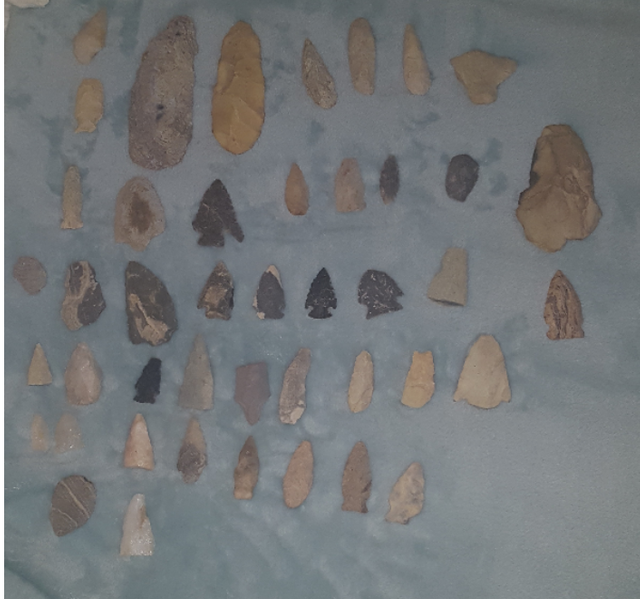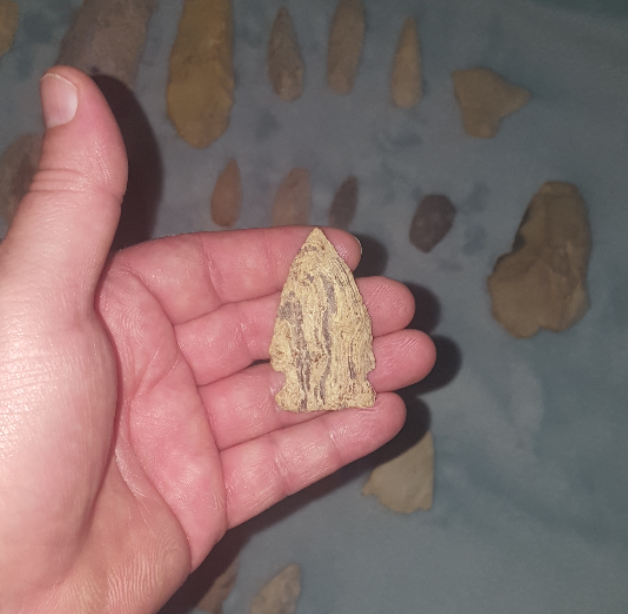Arrowhead Hunting (pt.1)

When you grow up on a farm you necessarily develop a close relationship with the land. It's an inevitable by-product of the fact that you literally derive your sustenance, either directly or indirectly, from the land itself. It's a sort of symbiotic relationship where you take care of the land, nurture it, and care for it and in return you reap a harvest that will allow you to either sell enough to buy your necessities or the harvest fulfills the necessities themselves. Either way, you both live off and support each other in a way that is intangible to those who have never experienced it directly.
It's easy to wax philosophical about the benefits of a childhood spent on the farm thirty years later from my air-conditioned writing office. At the time, though, as a sweaty-faced, dirt encrusted, and often boredom stupefied eight-year-old those benefits are a lot tougher to spot and appreciate. That seems to be the way of life, though, that you never really realize how good you have it until you don’t have it as good anymore.
When I was growing up on my grandparents’ farm I was much less concerned with things like a puritan work ethic and respect for environmental symbiosis than I was with things like how far I could throw a dirt clod. But one thing that I’ve been passionate about from the beginning is what we in the fields of rural North Carolina call “arrowhead hunting.” In the spring and early summer plows rip through the top two feet or so of topsoil, turn the earth over, and uncover literal buried treasure. You just have to know where, and how, to find it.

Arrowhead hunting is something that was passed down to me from my maternal grandmother (Nanny). Some of my earliest and fondest memories are of us sitting in the family room on cold winter nights going through her massive collection by the fireplace. At the time she had the “nice ones” stacked in old cigar boxes under her bed. The rest were kept in buckets and boxes out in the shelter. And then there were untold thousands of shards, flakes, broken pieces, hammer stones, grinders, scrapers, etc. that got tossed into the trees at the edge of fields over the decades she spent walking that land. She taught me how to look for sharp corners and right angles, two things that nature rarely produces on its own, and how to spot different types of stone that just don’t belong in the sandy soil of the NC piedmont.
After picking all of the vegetables we could on mornings in the summer, Nanny would take me to the unused end of the garden field where the rows had been plowed, but never planted. We would walk slowly back and forth across the field, our eyes trained on the ground, our feet careful not to step on any stray stone until we nudged it with a toe to see if it was worth picking up or not. For a long time I walked those fields without any luck, thinking that perhaps all of the ancient stone tools had already been gleaned from the empty rows.
Then one day we were walking the end of the field after a stretch of three days where we’d had seemingly non-stop severe thunderstorms. The sudden downpour of rain in late July had left the field steamy and wet with tiny washed out canyons criss-crossing the neatly plowed rows. Nanny had found a few broken pieces of points, and the sharp tip of what looked like it would have been a large blade of some sort. I was beginning to get disheartened and to focus more on throwing rocks than looking for arrowheads when suddenly I stopped in my tracks. There in the dirt at my feet was a sharp corner that looked oddly out of place.
Thinking back now, I didn’t really consider at the time what it could be, I just knew that the thin, sharp point I was looking at sticking out of the sand didn’t look like the rest of the rocs around it. Carefully, with slightly trembling fingers, I bent and tugged on the corner, dislodging a stone covered in clumps of wet sand. It didn’t look like much at first, so I brushed away the sand to get a better look. And that’s when my heart leapt into my throat. I stood and stared at the point in my hand for a long time, too stunned to move.

The point, my first discovery that was totally my own, was made of a banded rhyolite that looked almost like the bark off an oak tree. It was medium-sized for the points in our area, and had been weathered quite a bit. But the ears (the little points hanging down by the bottom) were intact, the point at the end was still attached, and there didn’t appear to be any breaks. Not only was this my first find, but it was an intact point at that! And it was at that moment that the little kid in my kicked into high gear and I started dancing around and screaming with joy.
From that moment, I was hooked. It was twenty eight years ago this summer that I found my first arrowhead, and I still have a passion for this hobby. I’ll walk the fields at the farm back home until I blister from sunburn (true story, I’ve done it this year) looking for my next find. My wife can’t quite understand my fascination with arrowhead hunting, but it’s the thrill you get when you find one that’s kept me coming back time and time again.
There’s also nothing quite like the feeling of holding a tool that was shaped from stone by human hands hundreds, sometimes thousands of years ago. These tiny bits of stone represent a direct connection across thousands of years of human history to another person who walked the same ground as I. Whenever I hold one of these stone artifacts I find myself wondering about the last person to touch it. Were they a hunter tracking an injured prey animal through dense forests? Where they a warrior protecting their clan from encroaching hostile neighbors? Or were they a careless kid who dropped a dull and used up stone knife blade without even thinking twice about it?
We have found artifacts on our land dating from as far back as 10-12,000 BC. That is a mind boggling span of time when you stop to consider it. That means that for as much as ten thousand years people have been living on the land that my family now tends. To me that represents an incredible burden of responsibility for us to be good and careful stewards of that land. Our family’s name may be attached to it for now, but these tiny bits of stone are clear reminders that long after my family’s name has turned to dust and blown away on the winds, the land will remain.
**This is the first in a multi-part series about my adventures in arrowhead hunting and flintknapping (the art of making arrowheads). Hope you enjoyed, and if you have any questions feel free to drop them in the comments and I'll answer as many as I can.
**Also, if you're interested, here's a link where you can find out more about stone artifacts found in North America. Just click on any state/territory to get links and lists related to the artifacts most commonly found in that state. http://www.projectilepoints.net/Search/State_Search.html
Congratulations @dw-mcaliley! You received a personal award!
You can view your badges on your Steem Board and compare to others on the Steem Ranking
Vote for @Steemitboard as a witness to get one more award and increased upvotes!